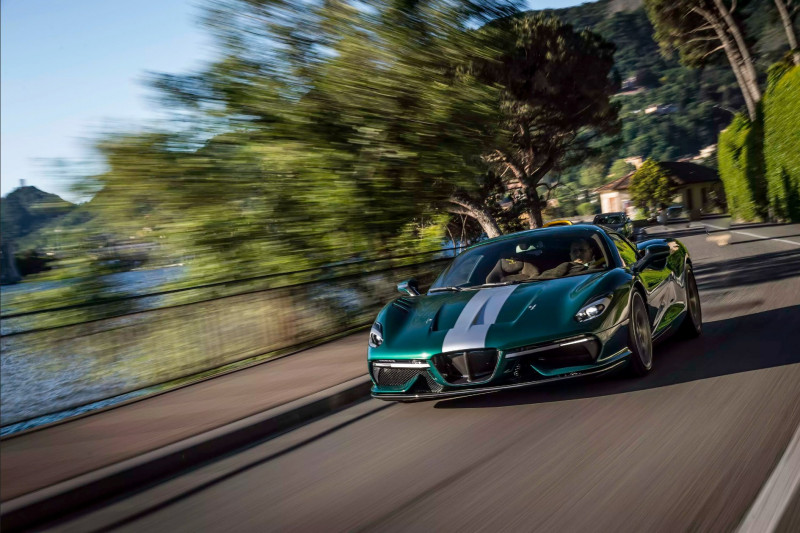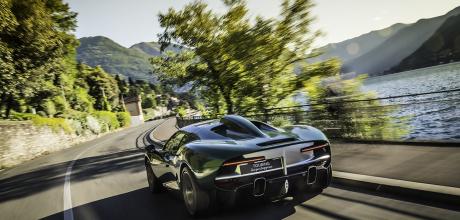2021 Arese RH95 by Touring Superleggera
Touring Superleggera’s latest stunner re-wraps the guts of an undisclosed ‘wellknown, mid-engined exotic’. Dale Drinnon discovers that the result is even more exotic. Photography Max Serra.
Hit cover version
Poke the throttle and the most delicious whoop imaginable swells up behind your shoulders, the kind that starts a chill rippling upwards from your spine until it brings the tiny hairs on your neck to trembling attention. Somebody please, please tell me why Italian V8s, no matter where they’re mounted, and I mean going clear back to the Otto Vu, sound so different from the good old home-grown versions of my native USA. And skip all the dry, empirical engineering reasons; I know about those already, at least a little. Just give me the lovely romance.

OK, yes, maybe not literally each and every Italian V8; I do remember a particular Maser that sounded so 289 Ford HiPo that my eyes got misty for a sec. But somehow the two varieties wind up provoking the same kind of ultimate anatomical excitement (ahem), while taking completely different routes in getting there.
Which is all by way of saying that the new Arese RH95 by Carrozzeria Touring Superleggera, the latest in its AERO series of aerodynamic designs, is a stirring, thrilling, and stunningly fast automobile that lost not a single step between the acclaimed mid-engined supercar donating the mechanicals and its re-birth as a coachbuilt example of stunningly fast luxury automotive sculpture. The phrase ‘rolling work of art’ is dreadfully hackneyed, and Lord knows I’ve done my share of the hackneying, but there it is, and like all of Touring’s AERO family, the purple prose richly applies. However, like the two flavours of V8, the Arese RH95 took a quite different route from its kinfolk in getting there. Of course, aerodynamic design has an illustrious history at Touring, with its longstanding philosophy of ‘shaped by the wind’ resulting in the industry’s first serious wind tunnel studies, as well as my candidate for the most beautiful racing cars humanly possible, the 1938 Alfa 8C Spiders that dominated the final pre-war open-road Mille Miglia.
Touring, in fact, considers that period the beginning of a whole Streamline genre for the carrozzeria; the AERO sub-set, meanwhile, came after Touring’s 1966 to 2006 hiatus (not ‘bankruptcy’; the founding Anderloni family stopped trading, but eventually paid every bill, in full) and subsequent restructuring under new ownership.
Head of design Louis de Fabribeckers specifically dates the modern AERO family from his delectable 2012 Disco Volante Coupé, and each evolution has carried forward shared details, or elaborated on common themes, to maintain a continuity of design, while always introducing innovative ideas and treatments to keep the results fresh and engaging. In a clever turn of servicing both those objectives simultaneously, de Fabribeckers also drew inspiration for new creations from Touring’s landmark machines of the company’s pre-’66 era, such as, obviously, the Disco Volante Coupé and Spyder, and those not considered part of the AERO family nonetheless suggested the great classic sports and GT machines of the front-engine days.
Until, that is, the Arese RH95. For the first time since the company’s founding, Touring’s craftsmanship is performed on a chassis of mid-engine configuration. What’s more, the car carries no references to milestones from its past, beyond de Fabribeckers’ dedication to Touring’s perfect proportions and clean, flowing lines.
The ‘95’ in Arese RH95 represents Touring’s 95th anniversary this year, while R and H are reportedly the initials of the project’s first client and enthusiastic patron, and ‘Arese’ refers to the Milan suburb of Touring’s HQ, plus its commitment to a successful future there.
Because this AERO is all about the future, and Touring’s place in it. ‘I think it is very important,’ de Fabribeckers told me during a Zoom conversation even before last year’s AERO 3 launch, ‘that we work with new technologies, new materials, new processes, and show what we can accomplish with them, because great craftsmen, great artists have always adapted to changing media, from a painter’s paints to new ways of welding.’ Consequently, both the Arese and the AERO3 have carbonfibre bodies, along with considerable amounts of carbon trim.
On the other hand, I asked him during my initial Arese walk-around this week if all this carbon meant the hallowed Superleggera bodywork of alloy panels supported by small steel tubes is now dead, and the answer was immediate. ‘Oh no, no, never. The construction will always depend on the shape, the style, the type of story we want the car to tell, the car’s mission; carbon is wonderful for the dramatic, the “showstopper” cars like Arese and AERO3, but for sharp, precise details like on the Berlinetta Lusso [which has exquisite, well-defined side creases, à la Touring’s seminal Ferrari 166 MM], we must always have metal, and all the traditional skills to make it beautiful.’
‘Ah,’ I replied, ‘so, horses for courses, then?’ He looked puzzled, this bright, disgustingly talented Belgian who taught himself Italian largely by chatting with the guys in the shop around the coffee machine, and as I explained that hoary old British horse-racing chestnut, his eyes lit up and he laughed like I was the combined Monty Python troupe. ‘Yes, yes! Horses for courses! I like this…’ And I am certain I will hear it the next time we talk; the man never forgets a thing.
From this walk-around, too, it’s evident that the Arese is the equal in fit, finish and build quality to the entire AERO series, and in all (utterly fake) modesty, I’ve driven and covered every model Touring has offered since the Disco Coupé, AERO or otherwise. There isn’t a raw edge to be seen here, and thoughtful details abound; each unit, for example, has plaques carrying its number in the limited build sequence, along with a panel inside the boot-lid autographed by each member of the Touring organisation, and a lovely piece of geometric art accents the headlamp casings, hidden away under the clamshell, because a design team-member thought it a nice touch – and de Fabribeckers agreed.
Perhaps more prosaic if also more practical, those scissor doors of which I had major suspicions turned out to pleasantly surprise me. The panel gaps are suitably even and well spaced; across pot-holed Milan city streets everything remains mercifully without squirms or wiggles, creaking or rattling. Maybe this is because the hinge pivots are sort of triangulated, one hinge residing along the shoulder-line of the front wing, the other in the front edge of the GT40-style roof cut-out. Regardless, it works, the side windows still roll down fully, and the extra window in the overhead section is kinda cool; wonder if I could get that with a Gurney-style helmet blister?
And the doors definitely fit this car’s personality. Outfitted in Verde Pino (pine green), plus splashes of silver and yellow, and bespoke wheels commissioned with a major specialist to the client’s individual pattern, the effect is decidedly racy, down to the functional dorsal scoop feeding the engine bay. If you think the scoop shows hints of Chaparral 2D, by the way, you’re right; early computer renderings also played around with shapes from the age of tall, skinny F1 supersnorkels, and headlamps of the Porsche 904 persuasion. Sounds like too much caffeine at the keyboard to me…
But then over-stimulation is a time-honoured part of the artistic process, and the end result is a flow of lines and a lightness of touch worthy of Touring’s ’49 Alfa Villa d’Este. It is clearly a modern design, but not of the modern design school, wherein a fast car has to look like it fell from a video game, with sharp, brutal corners, wings and flaps and spats throughout. I personally find the Arese’s best angle to be from the rear quarters: there is no Kamm effect by the textbook definition and no kick-up in the spoiler area; the car simply tapers to a graceful, elegant conclusion. Seen from above, it could be a living thing that grew that way by nature.
As for Touring’s claim of easier entry through those scissor doors, it really is so, up to a point. Or let’s say climbing into the heavily bolstered seats would be nigh-impossible with conventional doors, at least for those of us pushing the age of… well, never you mind what age I’m pushing. Still, anyone without my back problems should get used to the proper entry procedures in short order. Word to the wise: opening the doors is much easier if you start them moving with a slight nudge and let the gas strut help with the heavy lifting.
Once in those seats, however, they are supremely comfortable, and Touring’s rather cosy ‘cocoon’ idea of driver and passenger environments carries forward from the AERO 3 with very satisfactory marks. Car One is furnished in carbon and old school fake mouse fur, although almost infinite possibilities exist for personalising this space, maybe stretching to fur from actual mice if you only ask. ‘We rarely say “no” to a client’s wishes,’ de Fabribeckers maintains, and client input is actively encouraged during the full build process; they aren’t merely getting a car, they’re becoming a part of Touring’s history and traditions.
How does it drive? Thought you’d never ask – it drives exactly like the supercar that donated the running gear. Which is rather the point, and Touring goes to great lengths to ensure it does. In other words, it’s Earth-shakingly fast and totally capable, just as every road test says, and the value-added part from Touring is making it also a hand-crafted masterpiece. As for the exact beast under those delicious lines, I’m not at liberty to divulge that information, nor does Touring feel the need to release it. I’d suggest Google; you’ll find answers immediately. Or qualified buyers can easily find out from Touring. But not from me.
The fine print? Prices are something else not publicly announced, but mainly because they’ll vary so widely according to the client’s wishes. Do bring a chequebook with plenty of room for zeros, though, and contact Touring via its website before the limited run of 18 vehicles dries up. Or more precisely, 15 vehicles, now; at the time of writing two more have already been spoken for. Delivery should be expected in six months from receipt of the donor car at the Milan works and, if you don’t own an appropriate specimen, Touring can source one for you.
Oh, and if you see an Arese RH95 with a Dan Gurney helmet blister cruising down the M40, my lottery numbers must have finally come good. Give me a wave; don’t worry, I’ll know it’s you.
SEE THE Touring Superleggera Arese RH95 for yourself when it makes its UK debut at Salon Privé, Blenheim Palace, Oxfordshire, on 1-5 September, salonpriveconcours.com. To order yours, visit touringsuperleggera.eu.
2021 Arese RH95 by Touring Superleggera
- Engine 3902cc V8, DOHC per bank, twin turbochargers
- Max Power 710bhp @ 8000rpm
- Max Torque 561lb ft @ 3000rpm
- Transmission Seven-speed dual-clutch automated manual with paddle-shift, rear-wheel drive
- Steering Power-assisted rack-and-pinion
- Suspension Front and rear: double wishbones, coil springs, driver-adjustable telescopic dampers
- Brakes Vented discs front/rear
- Top speed 211mph
- 0-62mph 3.0sec
Above Central overhead air intake dominates both from behind and above; ‘floating’ lights feature in tail opening; overall shape majors on fluidity rather than the recent trend for edginess. Above and opposite Plaque declares no.1 of 18; donor car’s identity is not stated by Touring, but retrimmed Ferrari F8 Tributo dashboard is a big clue; mid-engined exotic looks entirely at home on Italian roads. Below Rear three-quarter is the angle from which the Arese looks most classical; the scissor doors are a work of art in themselves.
‘It’s Earth-shakingly fast, and the value-added part from Touring makes it a handcrafted masterpiece’


